One of the most fun things about this hobby (obsession?) is propagatingPropagating (PRAH-puh-gate-ing) a plant is to grow another p... succulents for yourself. If you are seriously addicted to these beauties, you really need to know how to make more plants from those you already have. You can grow your collection for free just by taking advantage of the natural abilities the succulents have devised for their own reproduction and survival. You will find many (many!) uses for succulent cuttings, and some vendors sell succulent cuttings for much less than fully rooted plants. Learning how to grow succulents from cuttings is really easy. I’ll take you through it step-by-step and finish with some frequently asked questions. Because I find it easier to learn something new when I understand the whys involved, let’s look at how to propagate succulents from the plant’s perspective. 🙂
How to Grow Succulents from Cuttings
In this Post We'll Cover:
- How to Grow Succulents from Cuttings
- Propagating Succulents
- Propagating Succulents from Stem Cuttings
- Taking Stem Cuttings for Succulent Propagation
- What Size Cutting for Propagating Succulents?
- Remove Leaves from Stem Cuttings to Uncover the Nodes
- Which Way Up? How to Orient Your Stem Cuttings
- Let Stem Cuttings Callous Over
- Insert Stem Cuttings into Soil for Rooting
- Most Succulents Can Be Propagated from Stem Cuttings
- More Stem Cuttings for Propagating Succulents
- Stem Cutting is Rooting
- How Long Does Succulent Propagation Take?
- Propagating Succulents
- Succulent Stem Cuttings FAQs
- Propagating Succulents – Which Can Be Propagated by Stem Cuttings?
{Please note, some links in this post may be affiliate links to sites that pay me a small commission if you click on the link and make a purchase. This commission is at absolutely no cost to you. I only recommend products and companies that I have worked with and truly love! ~Kat}
Propagating Succulents
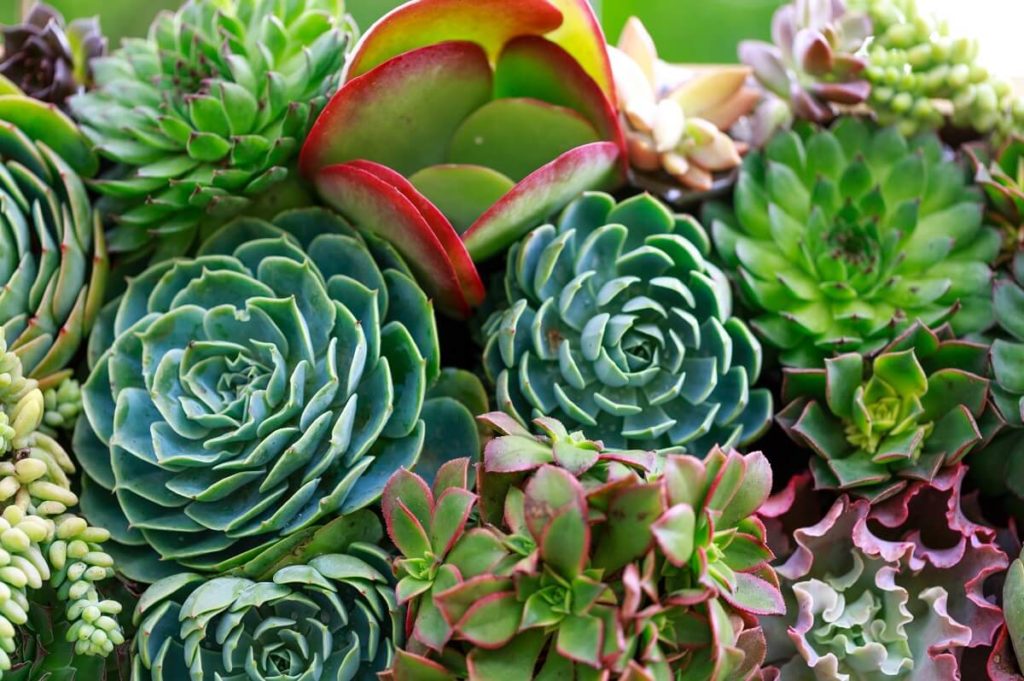
When you propagate succulents (or any type of plant), you are taking one plant and making another or many other individual plants from it. Like all life forms, plants strive to live and reproduce. Because they cannot run away to avoid damage due to wind, foot traffic, being munched on, etc., they have evolved methods of reproduction that can make use of these environmental hazards to make more plants.
There are four primary methods for propagating succulents:
- Stem cuttings – the vast majority of succulents can be propagated by stem cuttings
- Leaf – most succulents can be propagated from just a single leaf
- Division – some succulents can be propagated through division
- Seeds – many succulents can be grown from seed
These propagation methods apply to all plants, not just succulents. The easiest method that applies to the greatest number of succulent varieties is stem-cutting propagation. This is the method we will focus on today. I have covered other techniques for propagating succulents in other posts.
Propagating Succulents from Stem Cuttings
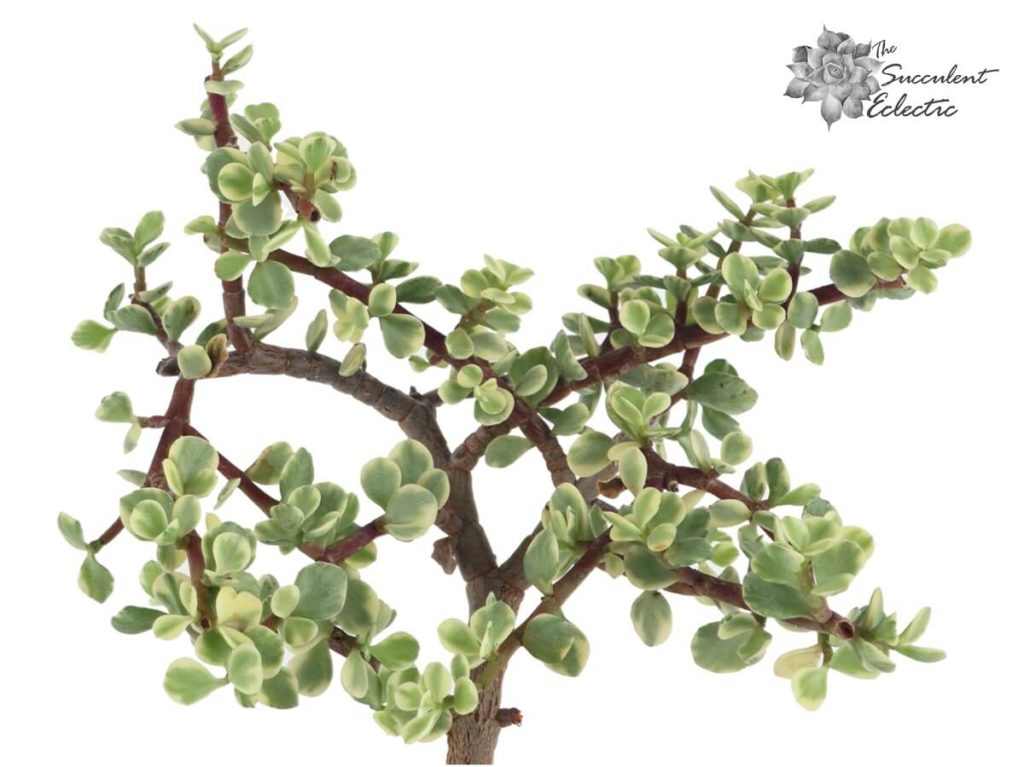
There is something fairly magical about some of the stem tissues of succulent plants. Some of the cells of the plant, those located at the junction where the stem meets the leaf, are capable of something amazing. These cells can form different types of growth depending on the needs of the plant. If the greatest need is for water, these cells form roots. If the plant needs to collect sunlight to change it into nutrients, these cells form leaves. These undifferentiated cells form the “meristemMeristem (MEHR-i-stem) tissue in plants contains undifferent... tissue” of the plant. Meristem cells in plants are somewhat similar to stem cells in animals.
If a plant growing in nature has a branch broken off, that drops to the earth, what happens? With succulents, that fallen branch will often sprout roots from its meristem tissues that reach into the soil, providing moisture for the remaining leaves. In time, it becomes a whole, new, self-sustaining plant. Stem-cutting propagation makes use of this natural ability of plants. It takes a part of the stem from a plant that was growing leaves and persuades it to form roots instead.
Taking Stem Cuttings for Succulent Propagation
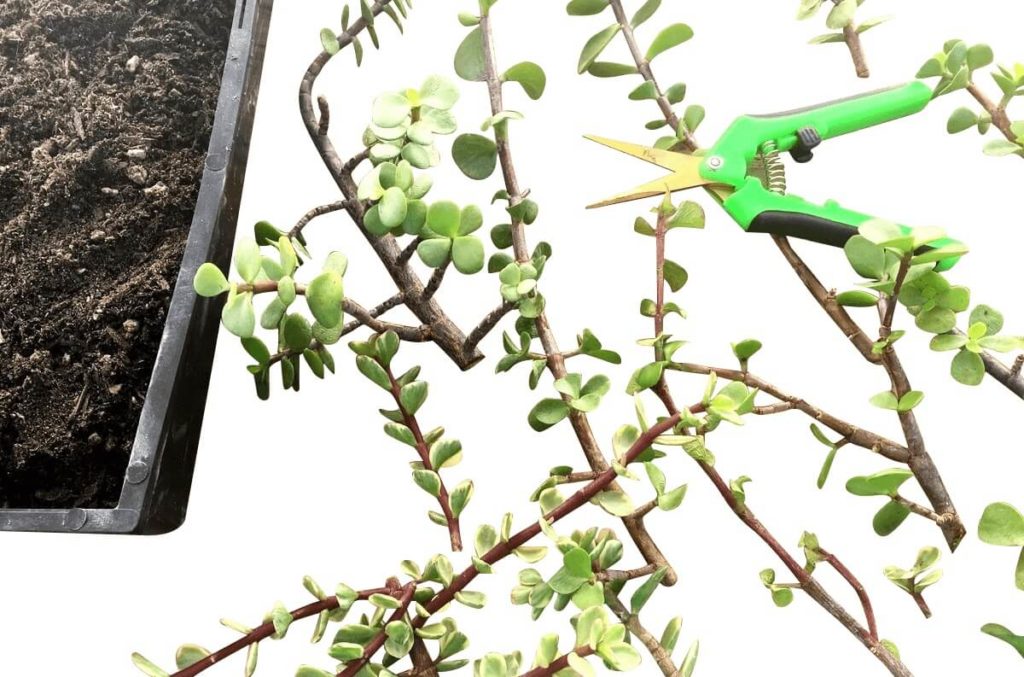
Portulacaria afra and its variegated siblings are among my favorite succulents. And they are perfect for demonstrating stem-cutting propagation! See how many of the stems have smaller stems of their own? This gives you many opportunities for making stem cuttings to root.
Be sure to use clean, sharp pruners to take your cuttings. It helps to prevent unnecessary stress for the cutting and to prevent the introduction of bacteria. I really love my Joyce Chen trimmers, but any good, sharp pair works well.
What Size Cutting for Propagating Succulents?
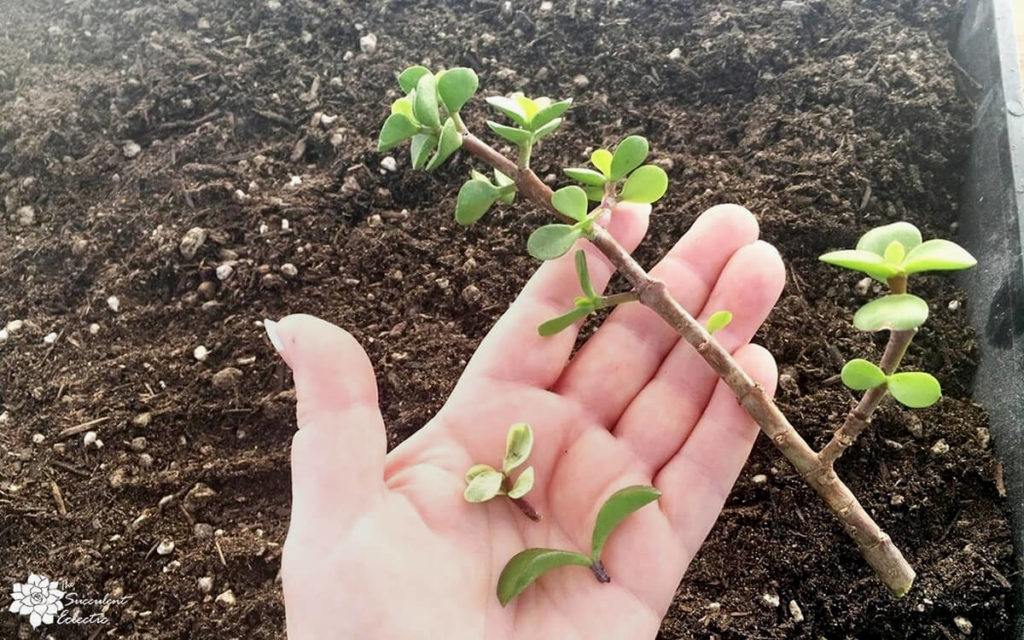
You can root any of these cuttings. All you truly need is the meristem tissue and an intact, healthy leaf. However, you will find that cuttings 2-4 inches long, with two sets of nodes for rooting and two sets of leaves, will be the quickest and easiest to root. You will see a node or uncover one by removing leaves from the stem:
Remove Leaves from Stem Cuttings to Uncover the Nodes
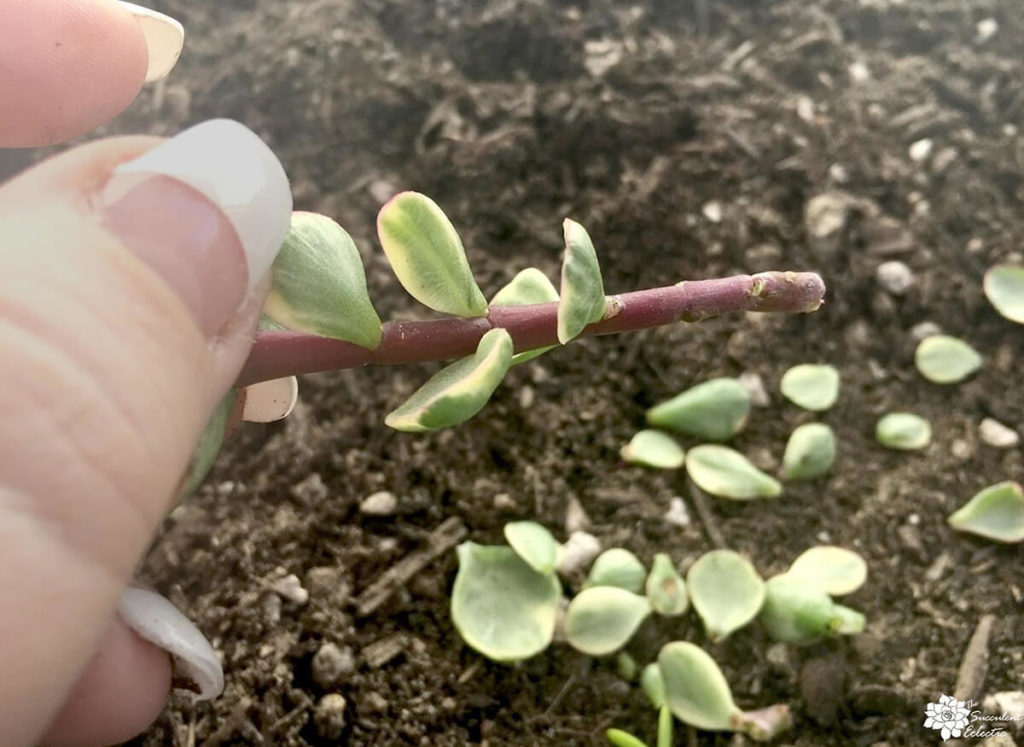
Do you see the two sets of nodes on this cutting? Each node is a point where new roots will form. So, two sets of nodes will give you at least four rooting points (assuming each set has a node on each side of the stem, which is how this portulacaria grows). Four rooting points will give this new plant a good amount of rooting to take up moisture and anchor the plant in place. It is important to keep the rooting zone in proportion to the part of your cutting that will become the top growth of your new plant. The healthy leaves will continue to provide the cutting with moisture and nutrients while it begins rooting.
Which Way Up? How to Orient Your Stem Cuttings
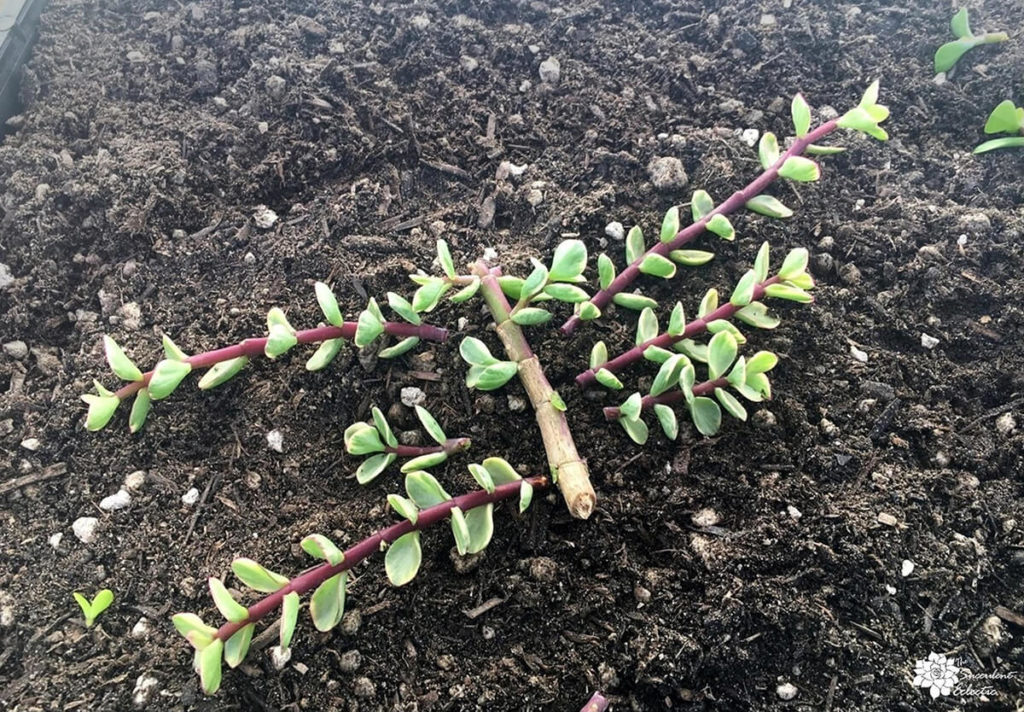
Also, take care with your cuttings to root the end that was lower on the plant when it was growing. Plants have a strict sense of up from down, and it is important to root the cutting from the point that was lower than the end that will retain its leaves. With a single stem, this is easy to determine. With a plant that has made multiple branchings, the end of the stem that is closest to the stem from which it was growing is what you will consider as “down.” You can usually tell by the way the leaves are oriented which part of the stem should be pointed “down” in order to root. If the plant you are taking cuttings from is not clear, make a note of this as you take your cuttings.
Let Stem Cuttings Callous Over
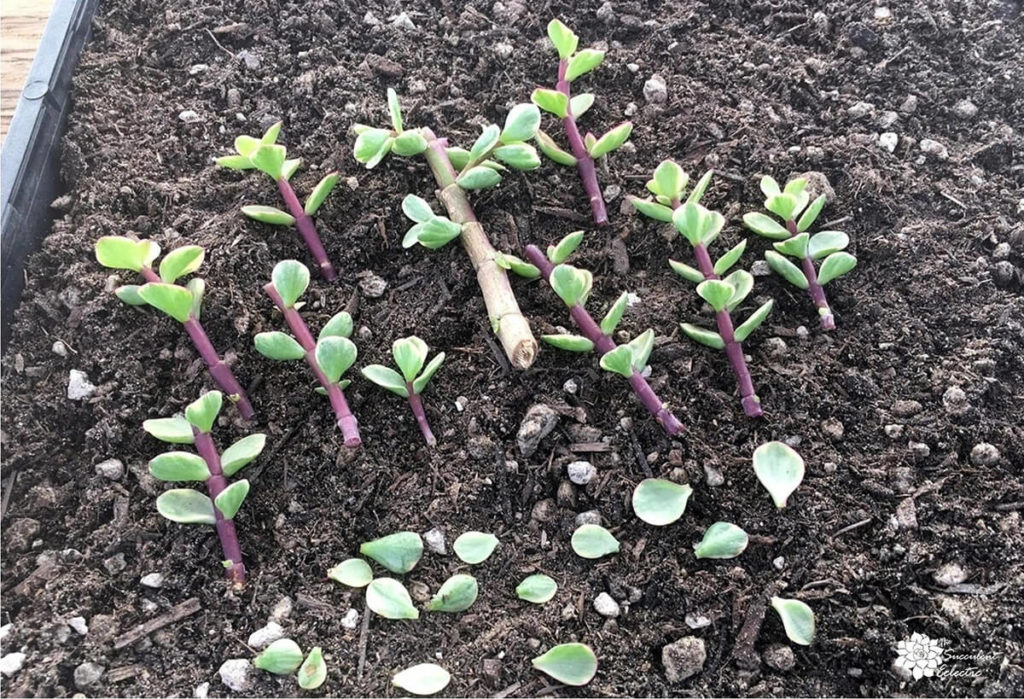
As you take cuttings, lay them out in the direction they should be oriented. Set aside leaves you remove for leaf propagation! 🙂 I set my cuttings on a flat of fast-draining succulent soil, out of direct sun for a few days after cutting them. This gives them a chance to callous over, which reduces the chance of rot down the road.
Insert Stem Cuttings into Soil for Rooting
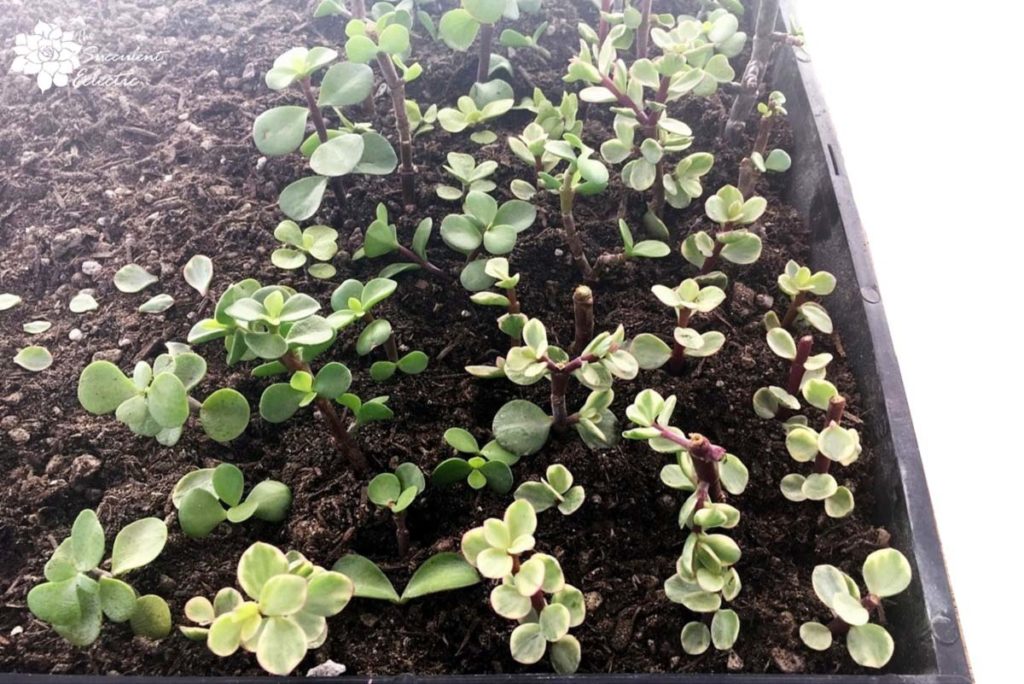
After 2-3 days, go ahead and insert the root end of your stem cuttings into the dry succulent soil. Give them a bit of space, but since they will not grow to maturity here, crowding is not a problem. Once you have inserted them into the dry soil, return them to a spot out of direct sun, but that does get indirect light. Wait about two weeks, and then mist the soil well. From this point on, continue to mist well once each week.
Most Succulents Can Be Propagated from Stem Cuttings
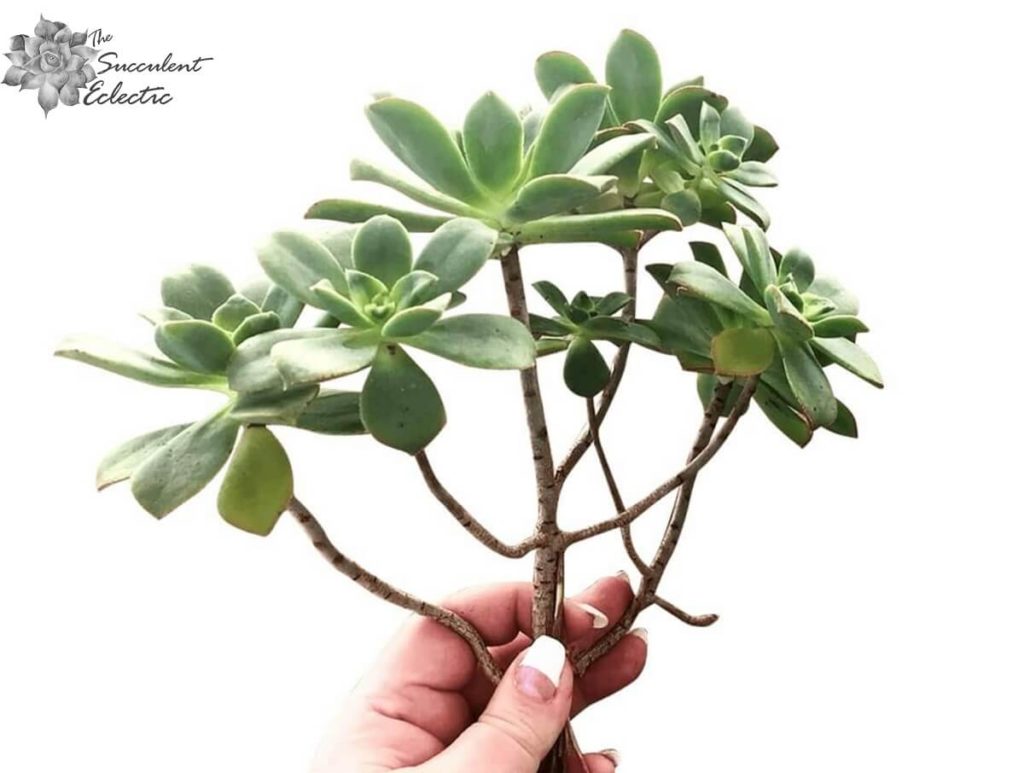
The vast majority of succulent varieties propagate well from stem cuttings. This branch of aeonium kiwi can be cut down to many cuttings, one for each rosette. If you have several plants you want to take cuttings from, there is no problem rooting them in the same flat.
More Stem Cuttings for Propagating Succulents
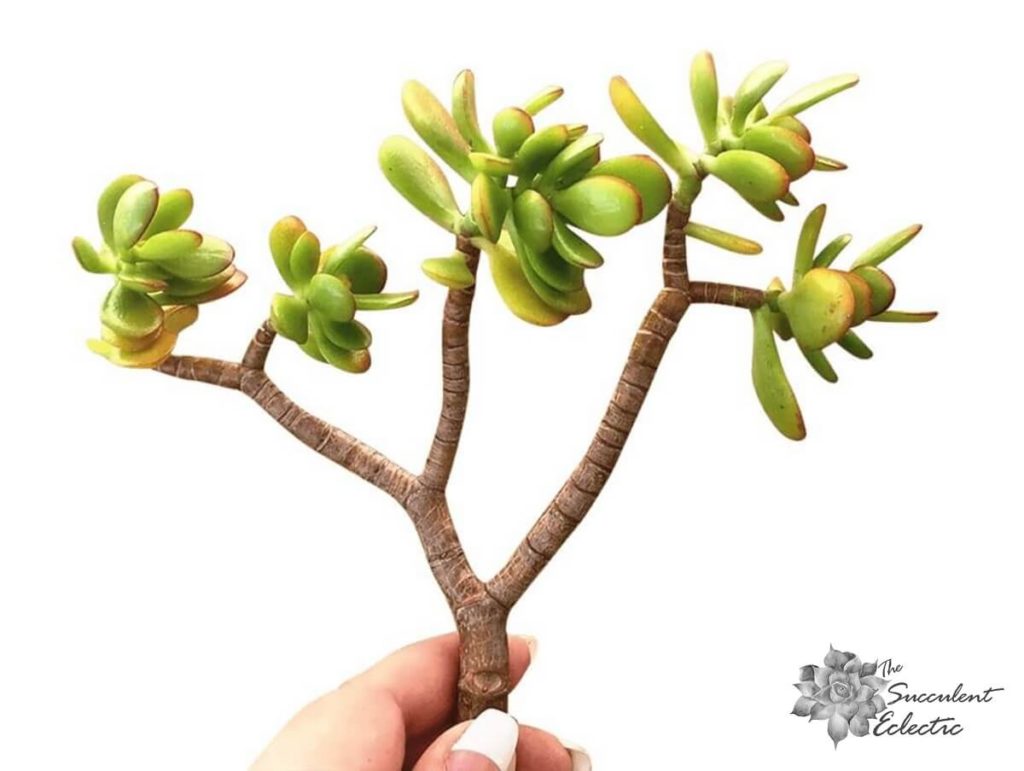
Crassula ovata is another variety that does very well with stem cuttings. Although the nodes look quite different from those of the aeonium and portulacaria, they are still quite obvious. The lines around the stem occur at each node point. This branch can be cut down into several stem cuttings.
Stem Cutting is Rooting
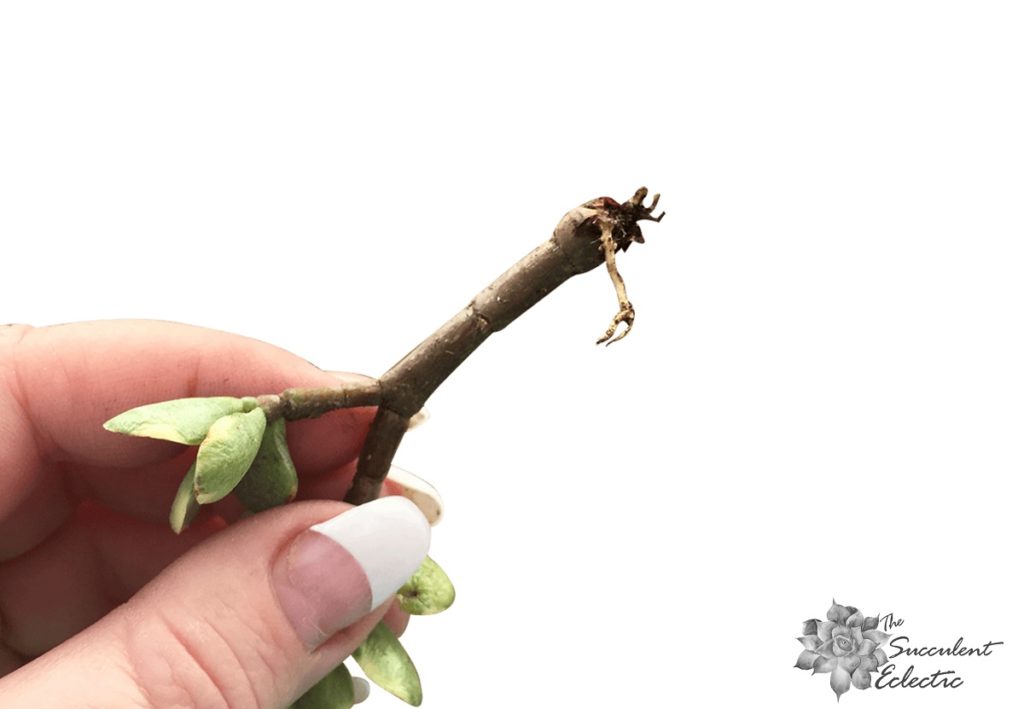
So, you have taken all of your cuttings. You gave them 2-3 days on top of dry succulent soil, out of direct sun. Then, you inserted them into the soil and left them dry for two more weeks. Then, you misted the soil well. Continue to mist the soil well once a week for a while. Be sure to take a good look at your cuttings each time. You will see the leaves begin to dry out a bit and become a bit wrinkled. This is a sign the succulent plant needs water. When the succulent needs water, this stimulates the development of roots. In time, you will see the leaves begin to plump up a bit more and to look better. This is a sign that they have begun to root, and the roots are able to take up water! Yay! (It is so exciting!) If a gentle pull on the cutting meets resistance — it has rooted. You can see a forked root here, and there are additional tiny little roots forming. It is time to plant this little one up and slowly introduce it to more light.
How Long Does Succulent Propagation Take?
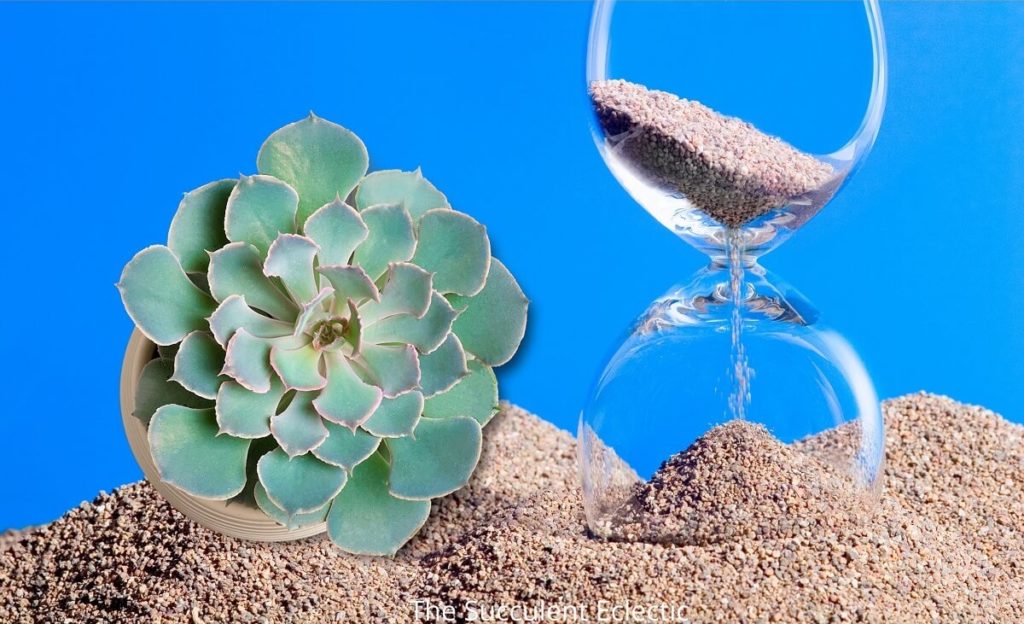
Propagating succulents by stem cuttings can be done successfully much of the year. The amount of time it takes from cutting to rooting will vary with the season, length of daylight hours, temperatures, succulent variety, etc. You will often see roots develop in just 2-3 weeks, but it can also take several months. This is not a fast process — but it is reliable. If you know you need x number of succulent plants at a certain time, plan to buy them. But to increase your collection, propagation is a great way to go. You will also find some terrific bargains online if you are willing to receive cuttings rather than rooted plants. There are some excellent vendors who do offer succulent cuttings, either for use in crafts or as an inexpensive alternative to purchasing plants.
Should You Use Succulent Rooting Hormone?
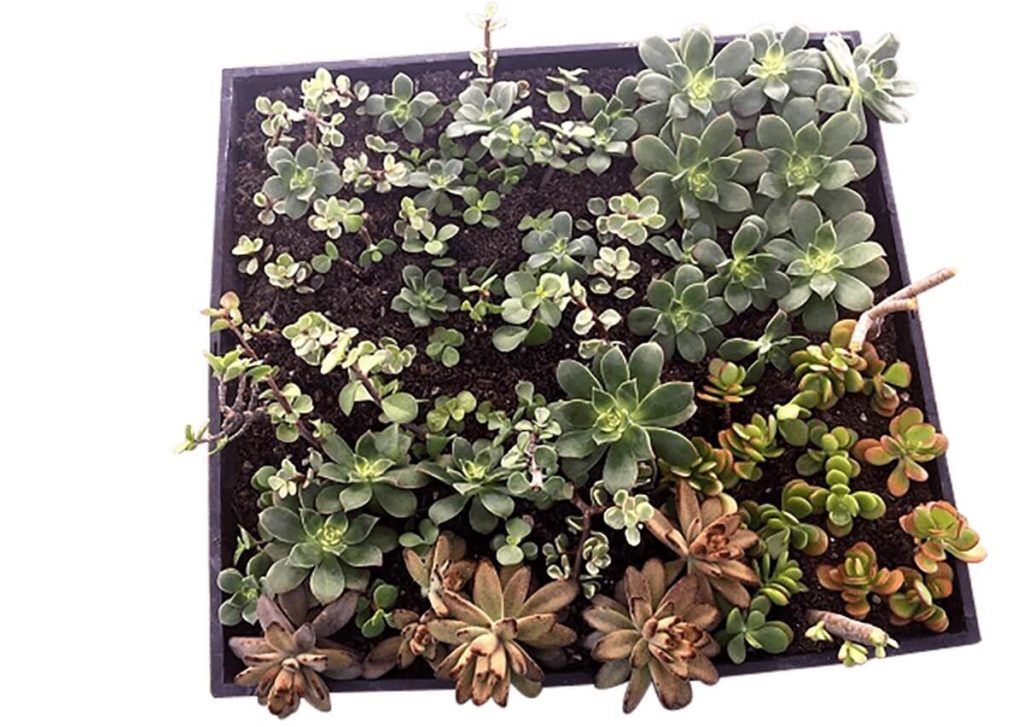
Over the past 25+ years, I have experimented many, many (many) times with propagating plants of all types. I have used rooting hormones, aspirin, willow bark water, honey, and nothing at all. I do find the hormone powder and willow bark useful with really stubborn, woody perennials. But for succulents, it just does not seem to make any difference that I can tell. Why buy and use something you just don’t need?
Succulent Stem Cuttings FAQs

Can you put succulent cuttings straight into soil?
Once you take your succulent stem cutting, slip it directly into dry succulent soil. The cut end will callous over well even though it is in soil. Set it out of direct sunlight and do not water. After two weeks, give the cutting a very gentle tug. If it slides right back out of the soil, it has not rooted yet and should be replaced. However, if it resists your pull, roots have formed. Once you have roots, water and slowly acclimate the new plant to the appropriate amount of light.
How long does it take succulent cuttings to root?
The length of time it takes for succulent cuttings to root can vary by the variety, time of year, and growing conditions. However, many varieties will develop roots in 2-3 weeks.
How often should I water succulent cuttings?
Do not water succulent cuttings until they have rooted, or you risk rot. Until a succulent cutting has roots, it cannot make use of water in the soil. Once the cutting has developed roots, you can begin watering.
Propagating Succulents – Which Can Be Propagated by Stem Cuttings?
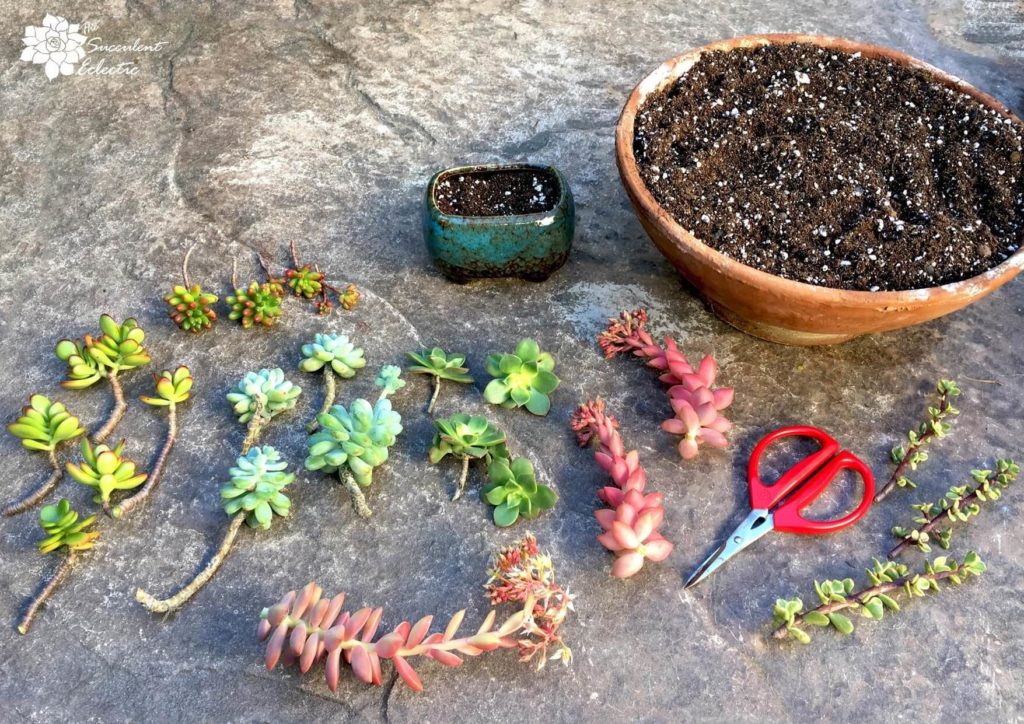
Propagating succulents from stem cuttings works beautifully with the vast majority of succulent varieties, including Aeonium, Crassula, Delosperma, Echeveria, Euphorbia, Graptoveria, Kalanchoe, Peperomia, Portulacaria, Sedum, Senecio, and more. Essentially, any succulent that is formed by a stem with leaves can be reliably propagated this way.
So — now that you know all about propagating succulents from stem cuttings, what plant will you start with first? I hope you are eager to get started. If you have any questions, please let me know — I am happy to help!
You can do this. I promise!

P.S. For my FREE course, 7 Steps to Succulent Success, please subscribe! Thanks so much!
P.P.S. Why not join my Facebook Group for succulent lovers? We talk about succulent care, propagation, succulent identification, and design. It’s a warm and welcoming group that would love to meet you!
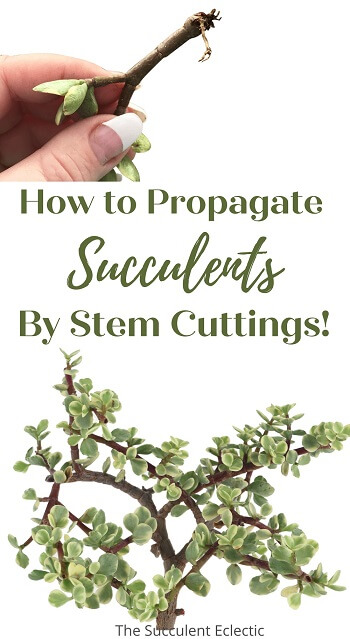
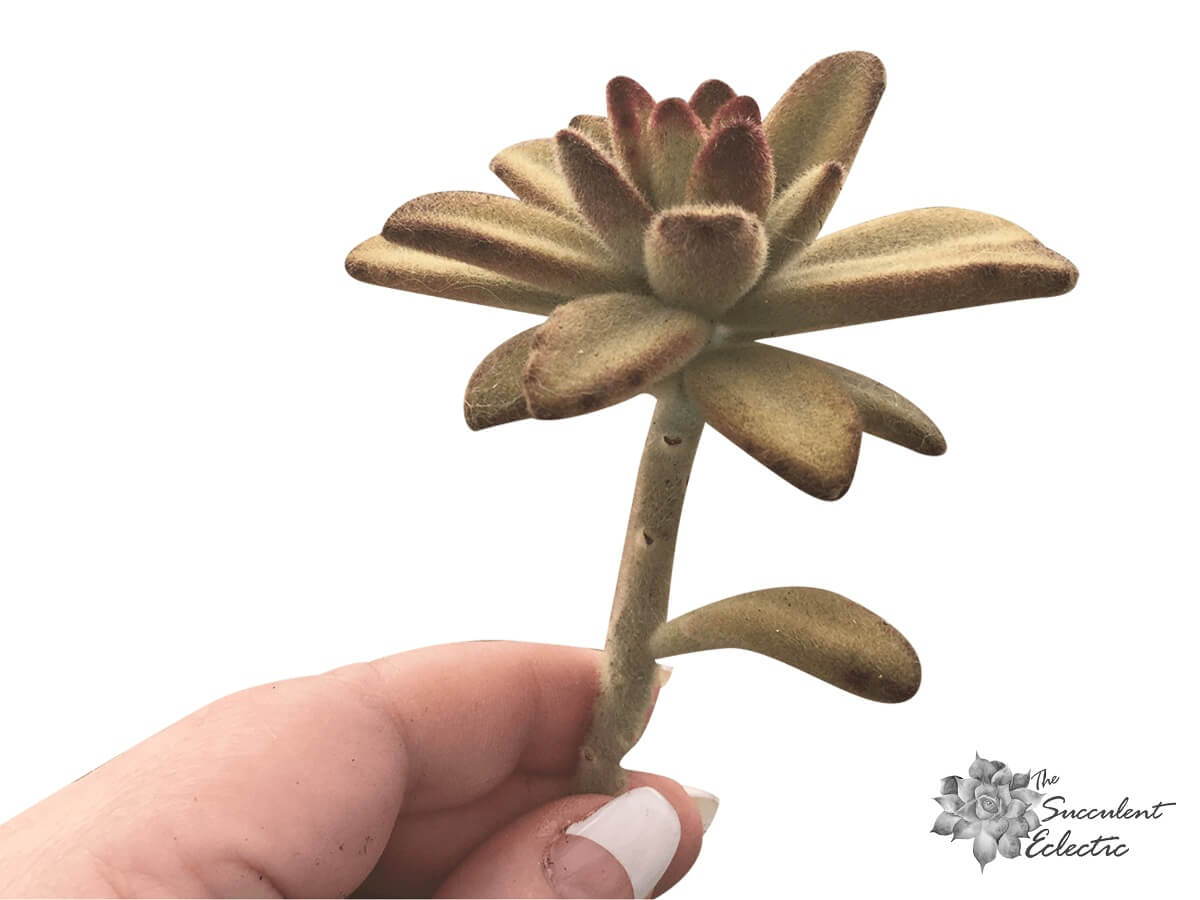


![Read more about the article 7 Simple Succulent Care Tips for Beginners [Infographic]](https://thesucculenteclectic.com/wp-content/uploads/2020/09/7-TIPS-FOR-succulent-beginnersjpg-300x169.jpg)